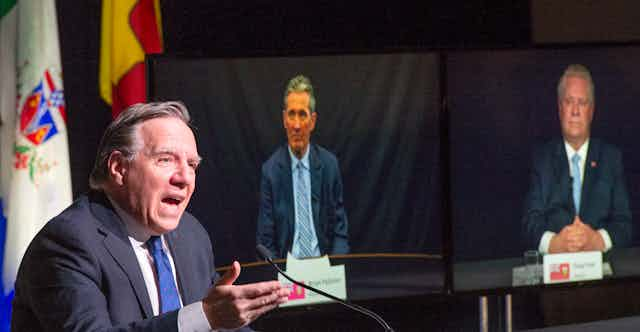In March 2021, Canada’s premiers again took up the issue of federal health transfers by reiterating a demand made in late 2020 for a $28 billion increase in annual federal funding for health care.
Their premise is simple. Once upon a time, the federal government contributed 50 per cent of the cost of medicare; now it contributes only 22 per cent. The provinces, it seems, are being generous by requesting that the feds need only raise their share to 35 per cent.
The problem is that the premise deliberately misrepresents the actual history of how federal transfers for health care evolved. As a onetime research co-ordinator for the Commission on the Future of Health Care in Canada — known as the Romanow Commission after Roy Romanow, the former Saskatchewan premier who helmed it — I’m fully familiar with that history.
It’s true that in the beginning, medicare costs were roughly split 50/50. But in 1977, the premiers agreed to fundamentally change that split under the Established Program Financing transfer.
Under this arrangement, medicare costs were reallocated as 50 per cent from provincial revenue, 25 per cent as a federal cash transfer and 25 per cent from the value of tax points transferred from the federal government to the provinces. The value of the tax points became provincial revenue and therefore made the provinces responsible for 75 per cent of medicare’s costs.
One-time transfer
But the myth of the 50/50 split being essential to health financing has been perpetuated by both federal and provincial levels of government.
The feds have liked to claim the value of the tax points as an annual transfer, making their financial contribution look larger and enhancing their reputation as a medicare defender. But it’s not an annual transfer; it was a one-time transfer that now generates annual revenue for the provinces.
The premiers want to ignore the value of the tax points because then they can plead poverty to Ottawa and bash them for no longer paying half of health-care costs. They conveniently forget that they agreed to this deal because the value of the tax points grows with the economy and they are free to spend that money with no conditions.
In 1995, in order to balance its own budget, the federal government unilaterally rolled all the cash transfers into the Canada Health and Social Transfer, known as the CHST. And they cut the value of that transfer significantly. The tax point transfer, however, remained in place.

The provinces were justifiably angry as they were left with two choices — either cutting spending or raising taxes. This led to the health-care wars of the late 1990s and early 2000s. In response, the 2002 Romanow Commission report called for a massive federal reinvestment in health.
In 2003, the Federal-Provincial Accord on Health Care Renewal split the CHST into the Canada Health Transfer (CHT) and the Canada Social Transfer (CST). Sixty-two per cent of the CHST cash went into the new CHT. The accord also provided an additional $16 billion as a Health Reform Transfer so the provinces could improve the performance of their health-care systems.
A health transfer increase
But the story doesn’t end there. In 2004, the 10-Year Plan to Strengthen Health Care saw the first ministers agree to an increase in CHT cash, a six per cent a year escalator and to roll the Health Reform Transfer into the CHT.
In 2011 the six per cent escalator was extended to 2016-17. In 2017, the feds set the escalator at a three-year moving average of growth in the GDP with a minimum of three per cent a year — not a cut in federal funding, but a decline in the growth of the federal contribution tied to economic performance.
As of 2017, there is no national health accord, but rather a series of essentially identical bilateral agreements with each province.

So when the premiers now turn around and say to the feds: “We’ll forget your 50 per cent obligation if you agree to pay 35 per cent,” they are being disingenuous at best and dishonest at worst.
A bargaining chip
The premiers’ demand is not a “return to traditional funding arrangements,” it’s a bargaining chip and should be treated as such. If the premiers want a $28 billion increase in the transfer (already pegged at $43 billion for 2021-22), then the federal government — and Canadians — must ask what it will get for that 65 per cent increase in its investment.

Will provinces enact long-promised but so far mostly undelivered reforms? Will they restructure how we pay physicians? Will they recreate primary health care across the board and integrate new professions? Will they effectively manage waits, renew infrastructure and improve outcomes?
Yet more cash without real change would be the real betrayal to Canada’s public health-care system.

